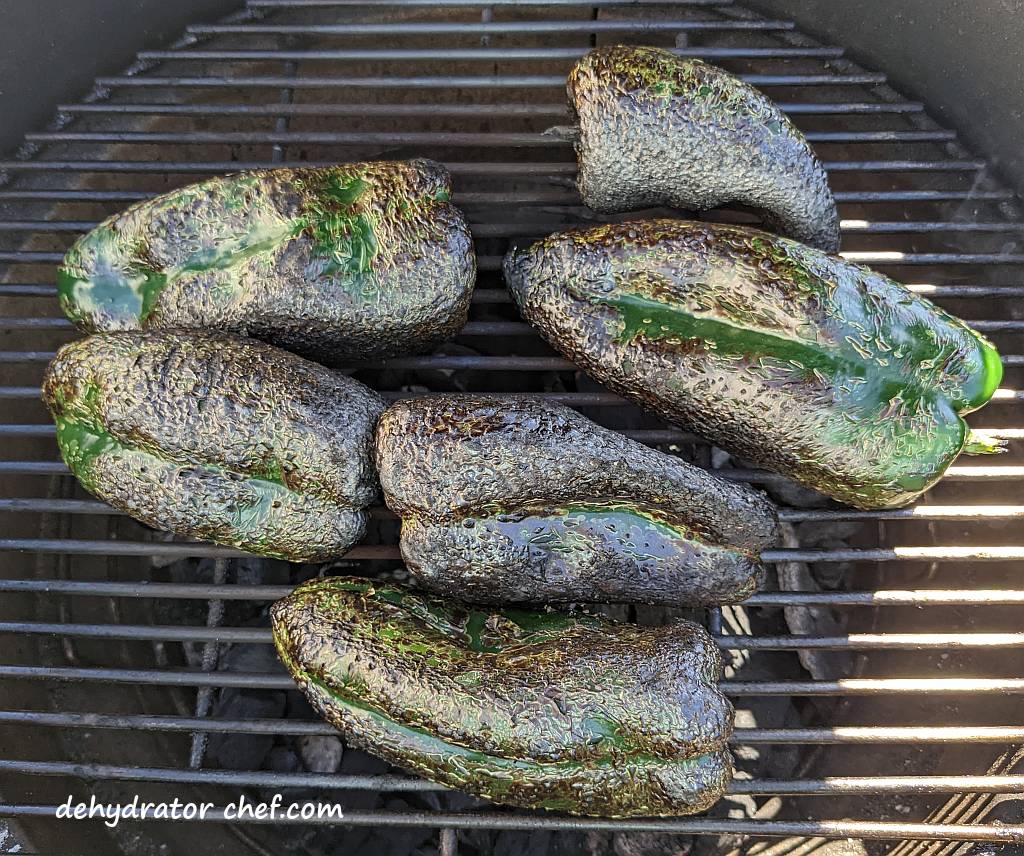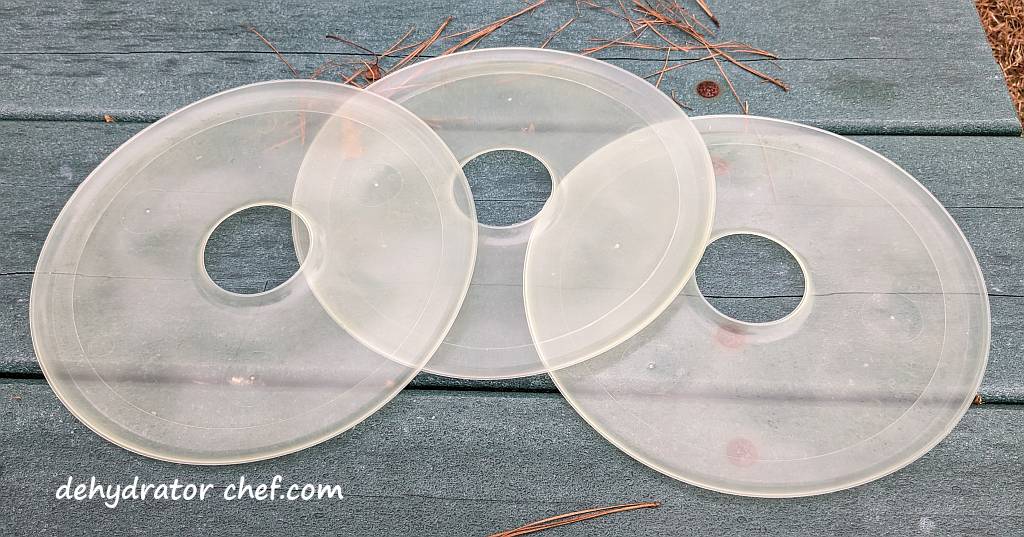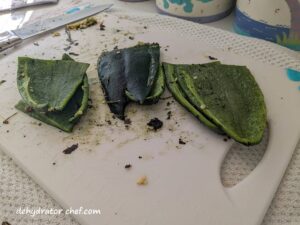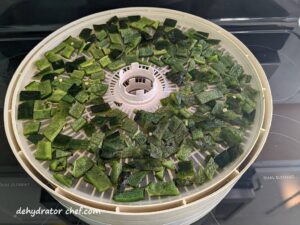This is our step-by-step guide on how to dehydrate poblano peppers. Dehydrating poblano peppers in your food dehydrator is easy to do. Dehydrated poblano peppers hydrate quickly and are perfect for camping and backpacking meals.

You can eat poblano peppers raw, but we are first going to fire-roast the peppers for added flavor. Fire-roasting poblano peppers are easy to do and their flavor really comes alive. You really don’t need to do this, but fire-roasted poblano peppers taste so much better.
So let’s get started dehydrating some poblano peppers.
Table of Contents
- How to Dehydrate Poblano Peppers
- Step 1. The Process to Dehydrate Poblano Peppers
- Step 2. Preparing the Dehydrator to Dehydrate Poblano Peppers
- Step 3. Dehydrating Poblano Peppers
- Step 4. When are the Dehydrated Poblano Peppers Done
- Step 5. Equalizing and Conditioning Dehydrated Poblano Peppers
- Step 6. Storing the Dehydrated Poblano Peppers
- Hydration
- Weights, Measures, and Serving Sizes
- Dehydrated Poblano Pepper Nutrition Information
- Insider Tips
How to Dehydrate Poblano Peppers
We love poblano peppers; they have a lot of flavor and practically no heat at all. The poblano is a mild pepper measuring between 1,000 and 2,000 on the Scoville Scale. They’re not as spicy as jalapeno peppers, which range between 2,500 to 8,000 Scoville Heat Units.
They are probably Mexico’s favorite chili pepper. When the poblano is fully ripened to a red color and dried, it is known as the ancho pepper.
All you need to dehydrate poblano peppers is a good-quality food dehydrator. We use the Nesco food dehydrators; you can check out our food dehydrator guide and learn why we think Nesco offers the best bang for the buck.
Supplies Needed to Dehydrate Poblano Peppers
- Food dehydrator
- Removable fruit roll sheet inserts, one for each dehydrator tray
- Wide-mouth canning jar funnel
- Canning jars with tight-fitting lids
- Standard kitchen tools, including cutting boards, chef’s knife, spatula, mixing bowls, etc.
- Desiccant packets (optional)
Step 1. The Process to Dehydrate Poblano Peppers
Blister and char the skin of the poblano peppers. We use our grill for this task.

Place the blackened poblano peppers in a large bowl and cover it with plastic wrap and a kitchen towel. Let the peppers steam for 15 minutes.

Cut the stem end off the poblano pepper and remove the seed pod. Wipe off the blackened skin. I find using the back of a knife to scrape off the charred skin works well. Do not rinse off the peppers under water. You’ll wash away the fire-roasted flavor.

Slice the peppers into 1/2 to 1-inch wide strips, then slice into smaller 1-inch bite-sized pieces.
Step 2. Preparing the Dehydrator to Dehydrate Poblano Peppers
You’ll need to use fruit roll sheets for dehydrating poblano peppers.

We will use these removable Nesco fruit roll sheet inserts on our food dehydrator for today’s project. They have over 3000 customer reviews with an average rating of 4.5 stars out of 5, which is evidence of a great product. Check out other Nesco food dehydrator products here.

Evenly spread out and create a thin layer of the fire-roasted poblano peppers onto the removable fruit roll sheet inserts for even drying. If it’s too crowded, prepare another dehydrator tray.

The Nesco 13.5-inch round food dehydrator tray has close to 119 square inches or .8 square feet of surface area for drying.
Step 3. Dehydrating Poblano Peppers
To save some time, you can start dehydrating the poblano peppers by setting the initial drying temperature to 160 °F (71 °C) for 2 hours. Then dial the temperature back to 135 °F (57 °C) until dry, approximately 8 to 10 hours.
Drying times are dependent on your food dehydrator, the ambient temperature and humidity, and how crowded you fill your trays. Remember to use drying times as a guide.

Step 4. When are the Dehydrated Poblano Peppers Done
Start checking for doneness in 6 hours. The peppers usually take 8 to 10 hours to fully dehydrate at 135 °F (57 °C), depending on ambient temperatures and humidity. Remember to use drying times as a guide.

Drying times will vary depending on your dehydrator. Refer to your dehydrator owner’s manual for recommended temperatures and times for dehydrating specific foods. Remember to use drying times as a guide.
Fully dried, the poblano pepper pieces will be hard, brittle, and snap in half when bent.

Warm dehydrating peppers still in the food dehydrator will feel somewhat pliable, and you may believe they need more drying time. Simply unplug the dehydrator, or just remove the tray and let it cool down. Then check again to be sure.
Dehydrated poblano peppers should be crisp and brittle when done.
Step 5. Equalizing and Conditioning Dehydrated Poblano Peppers
We always recommend letting food items cool completely after they have finished dehydrating and before packing them into an airtight storage container for equalizing and conditioning. Warm food may cause sweating which could provide enough moisture for mold to grow.

It does not take long for dehydrated food items to start hydrating from ambient household humidity. Do not leave dehydrated food items exposed to the elements any longer than necessary because of the increased risk of mold growth.
After a short cooling period, pack the dehydrated poblano peppers into a clean, dry, insect-proof, and air-tight storage container. We use quart-size canning jars for conditioning. Since the canning jars are clear, it’s easy to see what’s inside.
When the dehydrated poblano peppers are removed from the dehydrator, the remaining moisture may not be distributed equally among the pieces because of their location and position in the dehydrator. Equalizing and conditioning is a process for freshly dehydrated foods that ensures any residual moisture remaining in any piece is spread, or equalized, among all the other pieces in the batch. Let the dried peppers equalize and condition in the storage container for 7 to 10 days.
Every day, check the jar for moisture. Roll the jar contents around and note any clumping or sticking. If seen, put the contents back on the dehydrator for several more hours. Since canning jars are clear, it’s easy to see what’s inside.
If you notice any mold at all, even the smallest bit, throw it all out. What you see are the mold spores finally blooming enough to make them visible. But there are more, even tinier mold spores in the rest of your jar that make your dehydrated food inedible. Toss it out and start another batch.
Step 6. Storing the Dehydrated Poblano Peppers
Use an appropriately sized canning jar for storage. The dehydrated poblano peppers might keep up to 12 months. Exactly how long depends upon your pantry storage conditions.

We’ll use a food-safe desiccant packet for moisture control because we live in a fairly humid area. For our pint-size or quart-size mason jars, we’ll use a single food-safe 5-gram desiccant packet.
We use these inexpensive food-safe desiccant packets, which are available from Amazon. These 5-gram packets have over 5000 of mostly 4- and 5-star customer reviews, with an average of 4.7 stars out of 5. Our bag of 60 desiccant packets will last quite a while because they can be recharged and reused multiple times. Other food-safe sizes are available.

Lastly, attach or include a short note describing the jar contents and the date the product was dehydrated. The label identifies the canning jar contents, and the date helps with the rotation schedule. A first-in, first-out rotation helps us to use items that have been on the shelf the longest, so we’re using the oldest food first. This method helps us maintain the integrity of dehydrated products. The note also lets me know where to go in my dehydrator logbook if I want to make an update.
Hydration
Hydrate the dried poblano peppers using a 1-to-1 ratio of dehydrated peppers to boiled water. Plan on at least 15 to 20 minutes to fully hydrate.
If you’re supplementing store-bought freeze-dried meals as we do, just add a bit more boiling water to the food pouch. Use the same 1-to-1 ratio of dehydrated poblano peppers to water and account for the extra time.
Weights, Measures, and Serving Sizes
This information is a summary of the notes we keep in a logbook on most of our food dehydration efforts.
One large poblano pepper that we have processed will dehydrate to approximately 8 grams.
Dehydrated Poblano Pepper Nutrition Information
Serving Size: 8 grams | Calories:20kcal | Total Fat: 0g | Saturated Fat: 0g | Cholesterol: 0mg | Sodium: 3mg | Carbohydrate: 5g | Dietary Fiber: 2g | Sugar: 3g| Protein: 1g
 | The Dehydrator Chef Book Available only on Amazon.com You’ll find step-by-step instructions for 26 homemade dehydrated camping meals. Many recipes are only available in this book. Grab yourself a copy today. |
Insider Tips
Besides dehydrated meal recipes found here, add dehydrated poblano peppers to any of your favorite freeze-dried food pouches for a Mexican or southwestern flare, the Mountain House freeze-dried meals are easy to doctor up.
Just be sure to compensate by adding additional boiled water in a 1-to-1 ratio and allow enough time for adequate hydration.
Practice at home making dehydrated camping meals using the very same gear used in the field. We practice reinforcing the skills we have learned. Practice makes perfect.

How to Dehydrate Poblano Peppers
Equipment
- Removable fruit roll sheet insert (one for each dehydrator tray)
- Common kitchen tools (including cutting boards, chef's knife, spatula, mixing bowls, etc.)
- Canning jars with tight-fitting lids
- Desiccant packets for moisture control (optional)
Ingredients
- large poblano peppers
Instructions
Process the Poblano Peppers
- Fire-roast the poblano peppers on your grill over high heat. Blister and char the skin of the peppers.large poblano peppers

- Pull the fire-roasted peppers from the grill and steam them in a large mixing bowl covered with plastic wrap and a towel for 15 to 20 minutes.
- Remove the stem along with the seed pod from the peppers. Then, scrape off the blistered skin.

- Process the peppers by cutting them in half from top to bottom, then into strips, and finally into bite-sized pieces.
Prepare the Dehydrator
- Spread and layer the processed bite-sized pepper pieces on the removable fruit roll sheet inserts. If it’s too crowded, prepare another tray.

Dehydrate the Poblano Peppers
- To save some time, you can start dehydrating the poblano peppers by setting the initial drying temperature to 160 °F (71 °C) for 2 hours. Then dial the temperature back to 135 °F (57 °C) until dry, approximately 8 to 10 hours.

When are the Dehydrated Poblano Peppers Done
- Fully dried, the poblano pepper pieces will be hard, brittle, and snap in half when bent.

Equalizing and Conditioning the Dehydrated Poblano Peppers
- After a short cooling period, loosely pack the dried peppers into a clean, dry canning jar with a tight-fitting lid, leaving some headspace.

- Every day, for 7 to 10 days, check the jar for moisture. Roll the jar contents around and note any clumping or sticking. If seen, put it all back on the dehydrator for several more hours.
- If you notice any mold at all, even the slightest bit, throw it all out.
Storing the Dehydrated Poblano Peppers
- Use appropriate-sized canning jars for storage. Depending on how well you dehydrate it and your pantry storage conditions, the dehydrated peppers should keep for at least 12 months.

- An optional food-safe desiccant packet will aid with moisture control and enable a longer shelf life.

- Attach or include a label describing the jar contents and the date the product was dehydrated. The label identifies the canning jar contents, and the date helps with the rotation schedule. A first-in, first-out rotation helps us to use items that have been on the shelf the longest, so we're using the oldest food first.
Notes
Nutrition
Nutrition information is only an estimate and may differ depending on the ingredients you use.

3 replies on “How to Dehydrate Poblano Peppers – Dehydrating Poblano Peppers, A Step-by-Step Guide”
I didn’t remove the skins before I smoked and dehydrated. Is that going to be a problem?
Hi, you should have no problems with dehydrating the peppers with the charred skins left on. In my opinion, they add more flavor to the peppers. If you look closer at the pictures, you’ll see plenty of charred skin pepper pieces.
Great recipe for dehydrating poblano peppers, 5 stars all the way. Another keeper!